八年级英语上册Unit 2 Numbers More practice课件(共22张PPT,内嵌音频)
文档属性
| 名称 | 八年级英语上册Unit 2 Numbers More practice课件(共22张PPT,内嵌音频) | 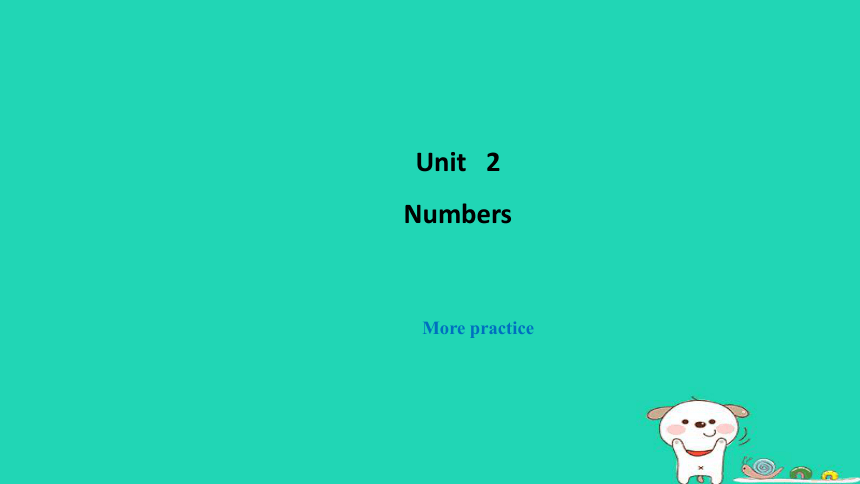 | |
| 格式 | pptx | ||
| 文件大小 | 12.1MB | ||
| 资源类型 | 教案 | ||
| 版本资源 | 牛津深圳版 | ||
| 科目 | 英语 | ||
| 更新时间 | 2025-02-06 10:20:56 | ||
图片预览



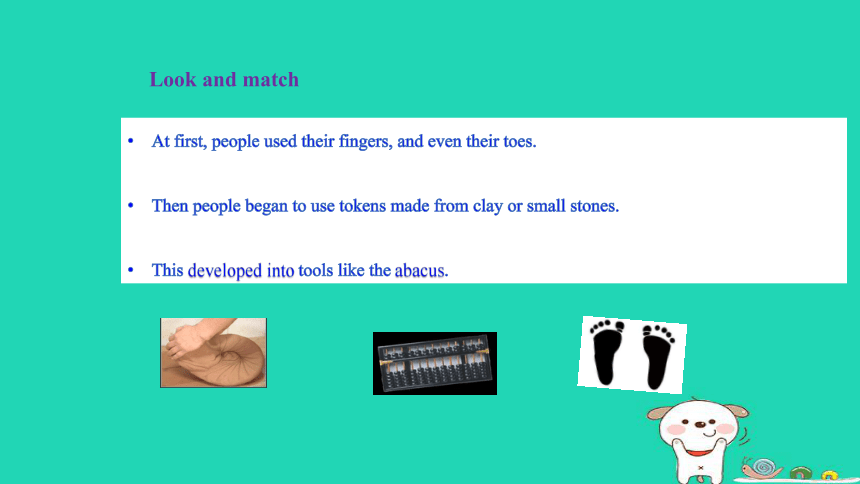


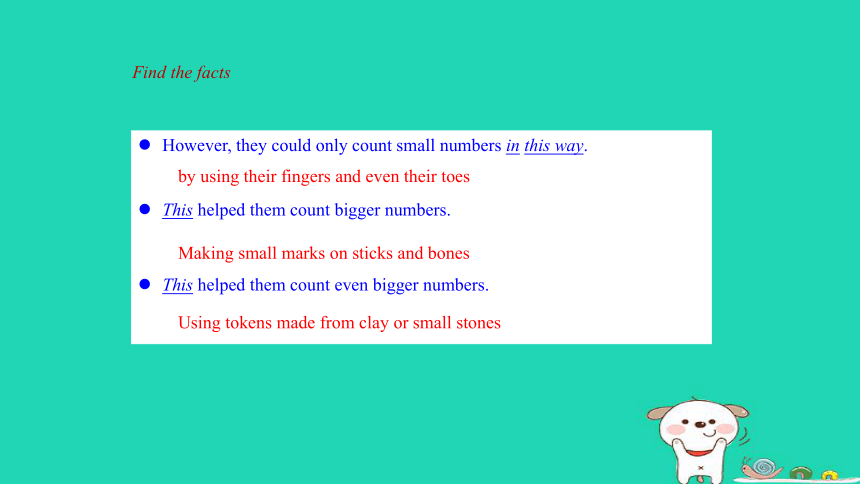
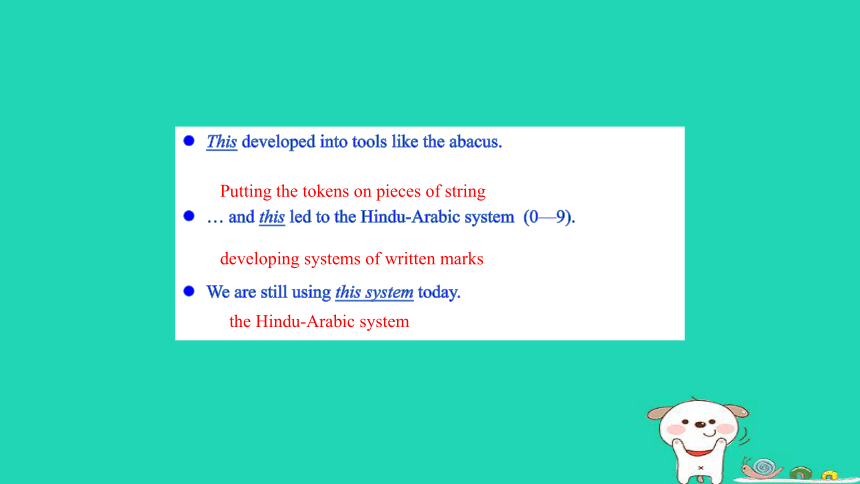
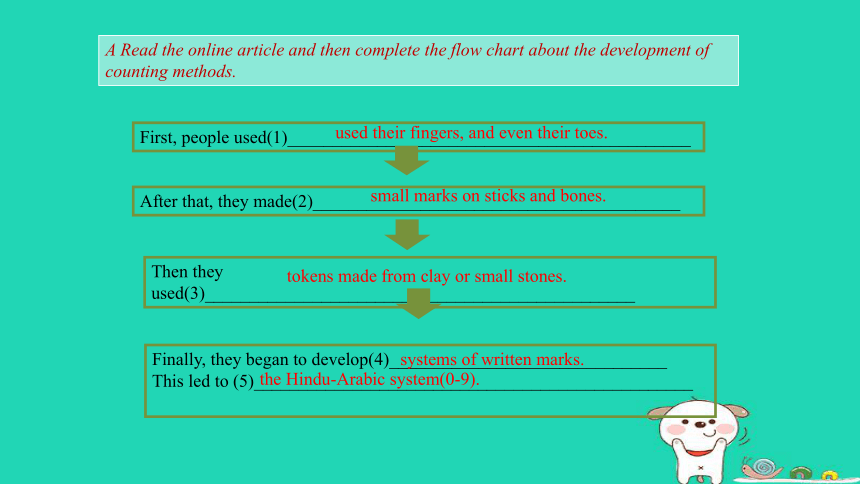
文档简介
(共22张PPT)
Unit 2
Numbers
More practice
Read the title, the first paragraph and the sequence words at the beginning of Paragraphs 2-5. Then make a spidergram.
Counting
before numbers
tokens made from clay or small stones
fingers and toes
marks on sticks and bones
b
a
c
d
the Hindu-Arabic system
c d a b
Read the first sentences in paragraphs 2-5 and then match the pictures below with the words in the box. Then put the pictures in the correct order.
At first, people used their fingers, and even their toes.
Then people began to use tokens made from clay or small stones.
This developed into tools like the abacus.
Look and match
Read the article and complete the table.
Things people used What to count Examples
fingers and toes
(small) marks on sticks and bones
tokens made from clay or small stones the abacus
systems of written marks
small numbers
bigger
numbers
even bigger numbers
the days of the month the amount of food the number of animals
the Hindu-Arabic system (0-9)
different numbers
However, they could only count small numbers in this way.
This helped them count bigger numbers.
This helped them count even bigger numbers.
by using their fingers and even their toes
Making small marks on sticks and bones
Using tokens made from clay or small stones
Find the facts
This developed into tools like the abacus.
… and this led to the Hindu-Arabic system (0—9).
We are still using this system today.
Putting the tokens on pieces of string
developing systems of written marks
the Hindu-Arabic system
Finally, they began to develop(4)_______________________________
This led to (5)_________________________________________________
used their fingers, and even their toes.
small marks on sticks and bones.
First, people used(1)_____________________________________________
After that, they made(2)_________________________________________
Then they used(3)________________________________________________
tokens made from clay or small stones.
systems of written marks.
the Hindu-Arabic system(0-9).
A Read the online article and then complete the flow chart about the development of counting methods.
Make a spidergram
small marks on sticks and bones
tokens made from clay or small stones
systems of written marks
Counting
before numbers
fingers and toes
1. They used them to count things like the days of the
month, the amount of food and the number of animals they had.
人们利用它们来数数,像每个月的天数,食物的数量还有他们所拥有的牲畜的数目。
amount 用作名词,意为“数量;总额”,通常用于a (great / large) amount of 短语中,表示“大量;许多”,其后通常接不可数名词。
例如: 他赚了很多钱。
He made a large amount of money.
Language points
注意the amount of 和the number of 的区别:
这两个短语都表示“……的数量”,其区别在于:前者与不可数名词连用,而后者与可数名词的复数形式连用。例如:
降雨量影响农作物的生长。
The amount of rain affects the growth of crops.
在过去的五十年里,老虎的数目锐减。
The number of tigers has reduced sharply in the last fifty years.
2. They often put the tokens on pieces of string so that they could carry them around easily.
他们经常把代币悬在绳子上,这样他们可以轻松地四处携带它们。
【句型】
so that 引导目的状语从句时,意为“以便;为了”,
从句中常使用can,could,may 等情态动词。注意,so ... that ...引导的是结果状语从句,意为“如此……以至于……”,试比较:
为了赶上早班车,他今早很早就起床了。
He got up early this morning so that he could catch the early bus.
他今早起得太晚了,以至于错过了早班车。
He got up so late that he missed the early bus this morning.
3. ... and this led to the Hindu-Arabic system (0-9).
……然后这最终形成了阿拉伯数字系统。
lead to 可表示:
(1) (道路)等通往……。例如:条条道路通罗马。
All roads lead to Rome.
(2) 引起(结果等);导致。
常见搭配:lead to + n. / v.-ing。
那场大雨引起水灾。
The heavy rain led to a flood.
懒惰导致考试的失败。
Laziness leads to failing the exam.
注意以下搭配:
lead sb to some place 把某人带到某地
lead sb to do sth 带领某人做某事
Numbers around the world
People around the world write numbers in different ways. The following shows how people from different cultures write one to five.
Chinese: 一、二、三、四、五
Romans: I, II, III, IV, V
English: one, two, three, four, five
However, most people around the
world use Arabic numbers
(1, 2, 3, 4, 5, etc.) today.
Culture corner
Romans
Chinese
English
Arabic numbers
Numbers around
the world
Project
A In groups, brainstorm some topics about numbers. Use the following spidergram to help you.
A mini-encyclopaedia of numbers
C In groups, write a short article on your topic. Follow the example.
1,We have learned about the development of counting methods.
2, We have learned people around the world write numbers in different ways.
such as :Chinese Romans English and Arabic numbers.
一、选择最佳答案填空。
( ) 1. We will only have a ____ examination this time.
A. write B. wrote C. writing D. written
( ) 2. Peter can use some different ways ____ out the problems.
A. work B. to work C. working D. worked
( ) 3. I think I can study English well ____.
A. in this way B. on the way C. by the way D. on my way
( ) 4. He studies English ____ better than me.
A. very B. so C. quite D. even
D
B
A
D
Unit 2
Numbers
More practice
Read the title, the first paragraph and the sequence words at the beginning of Paragraphs 2-5. Then make a spidergram.
Counting
before numbers
tokens made from clay or small stones
fingers and toes
marks on sticks and bones
b
a
c
d
the Hindu-Arabic system
c d a b
Read the first sentences in paragraphs 2-5 and then match the pictures below with the words in the box. Then put the pictures in the correct order.
At first, people used their fingers, and even their toes.
Then people began to use tokens made from clay or small stones.
This developed into tools like the abacus.
Look and match
Read the article and complete the table.
Things people used What to count Examples
fingers and toes
(small) marks on sticks and bones
tokens made from clay or small stones the abacus
systems of written marks
small numbers
bigger
numbers
even bigger numbers
the days of the month the amount of food the number of animals
the Hindu-Arabic system (0-9)
different numbers
However, they could only count small numbers in this way.
This helped them count bigger numbers.
This helped them count even bigger numbers.
by using their fingers and even their toes
Making small marks on sticks and bones
Using tokens made from clay or small stones
Find the facts
This developed into tools like the abacus.
… and this led to the Hindu-Arabic system (0—9).
We are still using this system today.
Putting the tokens on pieces of string
developing systems of written marks
the Hindu-Arabic system
Finally, they began to develop(4)_______________________________
This led to (5)_________________________________________________
used their fingers, and even their toes.
small marks on sticks and bones.
First, people used(1)_____________________________________________
After that, they made(2)_________________________________________
Then they used(3)________________________________________________
tokens made from clay or small stones.
systems of written marks.
the Hindu-Arabic system(0-9).
A Read the online article and then complete the flow chart about the development of counting methods.
Make a spidergram
small marks on sticks and bones
tokens made from clay or small stones
systems of written marks
Counting
before numbers
fingers and toes
1. They used them to count things like the days of the
month, the amount of food and the number of animals they had.
人们利用它们来数数,像每个月的天数,食物的数量还有他们所拥有的牲畜的数目。
amount 用作名词,意为“数量;总额”,通常用于a (great / large) amount of 短语中,表示“大量;许多”,其后通常接不可数名词。
例如: 他赚了很多钱。
He made a large amount of money.
Language points
注意the amount of 和the number of 的区别:
这两个短语都表示“……的数量”,其区别在于:前者与不可数名词连用,而后者与可数名词的复数形式连用。例如:
降雨量影响农作物的生长。
The amount of rain affects the growth of crops.
在过去的五十年里,老虎的数目锐减。
The number of tigers has reduced sharply in the last fifty years.
2. They often put the tokens on pieces of string so that they could carry them around easily.
他们经常把代币悬在绳子上,这样他们可以轻松地四处携带它们。
【句型】
so that 引导目的状语从句时,意为“以便;为了”,
从句中常使用can,could,may 等情态动词。注意,so ... that ...引导的是结果状语从句,意为“如此……以至于……”,试比较:
为了赶上早班车,他今早很早就起床了。
He got up early this morning so that he could catch the early bus.
他今早起得太晚了,以至于错过了早班车。
He got up so late that he missed the early bus this morning.
3. ... and this led to the Hindu-Arabic system (0-9).
……然后这最终形成了阿拉伯数字系统。
lead to 可表示:
(1) (道路)等通往……。例如:条条道路通罗马。
All roads lead to Rome.
(2) 引起(结果等);导致。
常见搭配:lead to + n. / v.-ing。
那场大雨引起水灾。
The heavy rain led to a flood.
懒惰导致考试的失败。
Laziness leads to failing the exam.
注意以下搭配:
lead sb to some place 把某人带到某地
lead sb to do sth 带领某人做某事
Numbers around the world
People around the world write numbers in different ways. The following shows how people from different cultures write one to five.
Chinese: 一、二、三、四、五
Romans: I, II, III, IV, V
English: one, two, three, four, five
However, most people around the
world use Arabic numbers
(1, 2, 3, 4, 5, etc.) today.
Culture corner
Romans
Chinese
English
Arabic numbers
Numbers around
the world
Project
A In groups, brainstorm some topics about numbers. Use the following spidergram to help you.
A mini-encyclopaedia of numbers
C In groups, write a short article on your topic. Follow the example.
1,We have learned about the development of counting methods.
2, We have learned people around the world write numbers in different ways.
such as :Chinese Romans English and Arabic numbers.
一、选择最佳答案填空。
( ) 1. We will only have a ____ examination this time.
A. write B. wrote C. writing D. written
( ) 2. Peter can use some different ways ____ out the problems.
A. work B. to work C. working D. worked
( ) 3. I think I can study English well ____.
A. in this way B. on the way C. by the way D. on my way
( ) 4. He studies English ____ better than me.
A. very B. so C. quite D. even
D
B
A
D
